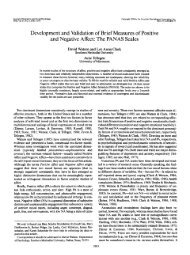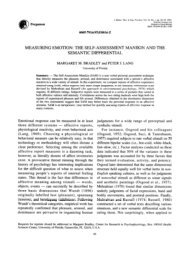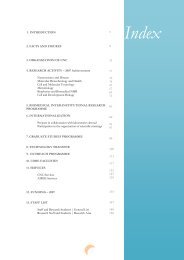Annual Report of Activities CNC 2008 - Center for Neuroscience and ...
Annual Report of Activities CNC 2008 - Center for Neuroscience and ...
Annual Report of Activities CNC 2008 - Center for Neuroscience and ...
Create successful ePaper yourself
Turn your PDF publications into a flip-book with our unique Google optimized e-Paper software.
Neuroprotection <strong>and</strong> Neurogenesis in Brain Repair | Head: João MalvaObjectivesThe research activity <strong>of</strong> the “Neuroprotection <strong>and</strong>Neurogenesis in Brain Repair” group is foundedon four main research pillars: 1‐ Neuromodulation;2‐ Neuroprotection; 3‐ Neuroinflammation; 4‐Neural stem cells <strong>and</strong> brain repair. This researchef<strong>for</strong>t aims at finding novel molecular <strong>and</strong> cellulartargets to prevent the progression <strong>of</strong> brain damage<strong>and</strong> to treat brain diseases.proven to be a valuable tool <strong>for</strong> drug discovery <strong>and</strong> t<strong>of</strong>unctionally evaluate the quality <strong>of</strong> differentiatedstem cell cultures <strong>for</strong> pre‐transplantation procedures.With this method we are able to functionallycharacterize a diversity <strong>of</strong> cells in the same culturesincluding: immature cell, astrocytes,oligodendrocytes, progenitors <strong>and</strong> neurons. Twopatents were produced (WO<strong>2008</strong>100168‐A1,PAT<strong>2008</strong>100089504/0198).In <strong>2008</strong> we focused particularly on the impact <strong>of</strong>neuroinflammation in neural stem cell fate. Themain objective <strong>of</strong> the research group has been thedevelopment <strong>of</strong> new competences <strong>and</strong> new tools tostudy neuroprotective <strong>and</strong> neuroregenerativepathways <strong>for</strong> brain repair purposes.Specific objectives included:1) To establish a novel single cell calcium imaging‐basedtool to functionally identify different neural phenotypesdifferentiating from neural stem cell cultures2) To identify novel proneurogenic <strong>and</strong> prooligodendrogenicfactors as well as new drugsaffecting neural stem cellphysiology/differentiation useful <strong>for</strong> stem cellbasedbrain repair strategies223) To develop new pharmacological procedures to treatneural stem cell cultures in order to boostdifferentiation <strong>of</strong> specific neural stem cell phenotypesin central nervous system disease models. Thesemodels included: temporal lobe epilepsy;methamphetamine‐induced neural damage;demyelinating diseases; retinal excitotoxic injury.At the long‐term, we aim to contribute with uniquetools to discover new molecular <strong>and</strong> cellular targets tobetter underst<strong>and</strong> neural stem cell biology.Ultimately, these tools will allow the identification <strong>of</strong>new targets <strong>for</strong> drug discovery <strong>and</strong> new pretransplantationprocedures <strong>of</strong> neural stem cells into tothe diseased brain.Main AchievementsWe developed a novel robust method useful toidentify the phenotype <strong>of</strong> living cells differentiatingfrom neural stem cell cultures. This method is basedin single cell calcium imaging technology <strong>and</strong> allowsthe simultaneous identification <strong>of</strong> more than 100 cellsin neural stem cell populations, matching uniquefunctional pr<strong>of</strong>ile <strong>of</strong> responses with the phenotypicmarkers <strong>of</strong> neural cell lineages. This method hasWe could identify the proneurogenic effect <strong>of</strong>neuropeptide Y (NPY) <strong>and</strong> tumor necrosis factoralpha (TNFalpha) in neural stem cell cultures derivedfrom the subventricular zone <strong>of</strong> the mice (SVZ).Interestingly, according to previous findings <strong>of</strong> thegroup in organotypic brain slice cultures, we foundthat TNFalpha exerts ambiguous effects in SVZcultures. At low concentrations TNFalpha inducesproliferation <strong>and</strong> differentiation <strong>of</strong> neurons (involvingJNK activation <strong>and</strong> axonogenesis) whereas at highconcentrations this cytokine is mainly toxic. Thesedata rein<strong>for</strong>ces the double effect <strong>of</strong>neuroinflammation in brain repair, depending on themagnitude <strong>of</strong> the inflammatory response to braininjury. Moreover, we also determined that NPY is apotent proliferative <strong>and</strong> proneurogenic peptide in theSVZ stem cell niche. NPY Y1 receptor is expressed<strong>and</strong> functionally active in the adult mice SVZ <strong>and</strong> itsactivation causes phenotypic <strong>and</strong> functional neuronaldifferentiation. These projects resulted in thepublication <strong>of</strong> three major manuscripts (one inRejuvenation Research; two in Stem Cells).






